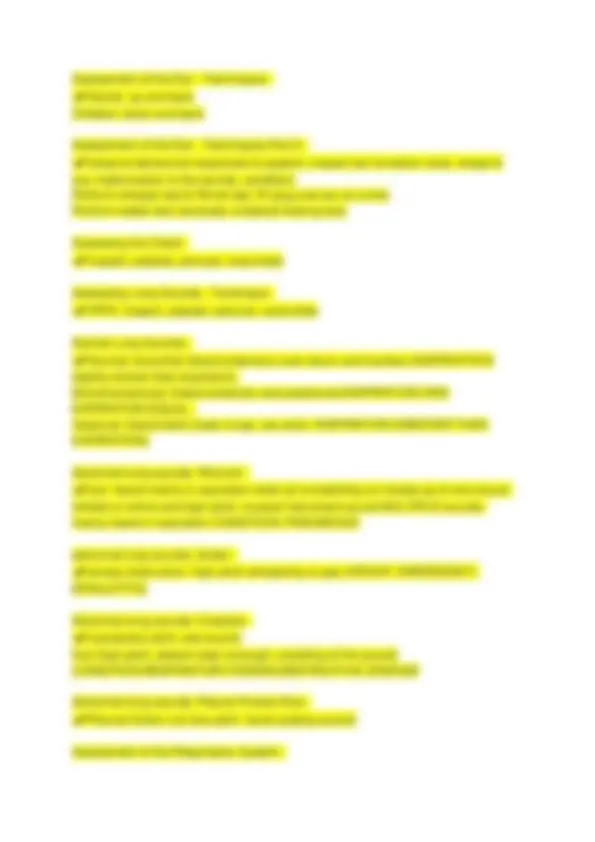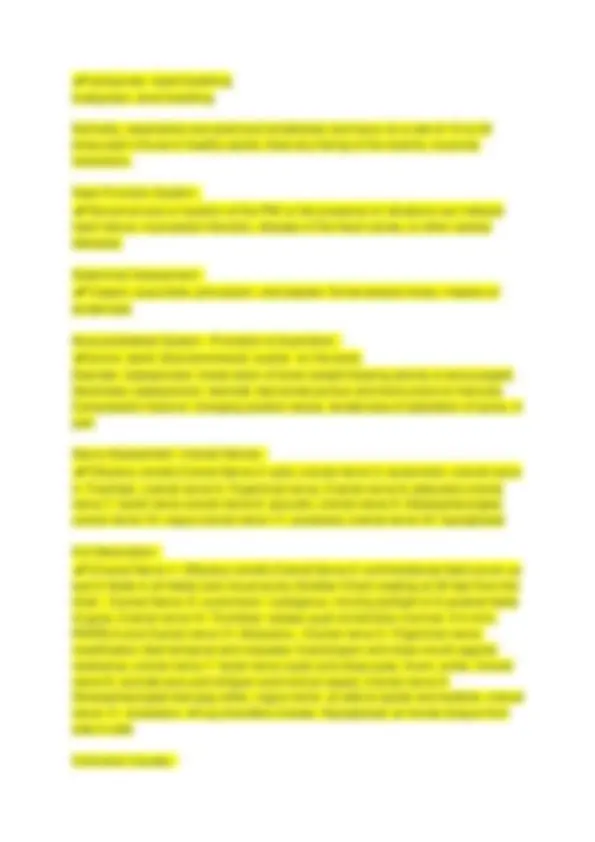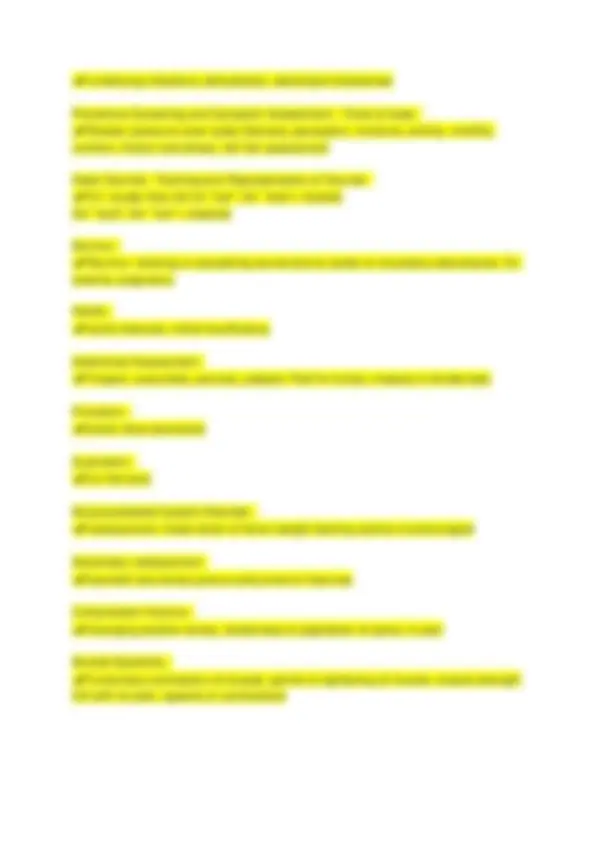





Study with the several resources on Docsity

Earn points by helping other students or get them with a premium plan


Prepare for your exams
Study with the several resources on Docsity

Earn points to download
Earn points by helping other students or get them with a premium plan
Community
Ask the community for help and clear up your study doubts
Discover the best universities in your country according to Docsity users
Free resources
Download our free guides on studying techniques, anxiety management strategies, and thesis advice from Docsity tutors
HESI Milestone Retake 48 Questions and Answers Latest Study Guide Latest 2025.pdf
Typology: Exams
1 / 5

This page cannot be seen from the preview
Don't miss anything!




Levels of Health Promotion - ✔️ primary, secondary, tertiary
Application Examples of Levels of Promotion - ✔️ primary- weight loss, diet, smoking cessation Secondary- papsmears, mammograms, testicular exams Tertiary- medication therapy, surgical treatment, physical therapy, teaching foot care education to diabetic care
Primary - ✔️ promotes health and preventing development of disease process or injury
Secondary - ✔️ screening for early detection of disease
Tertiary - ✔️ begins after illness is diagnosed and treatment. Aims to prevent long-term consequences of chronic illnesses or disabilities
Nursing Assessments - ✔️ Comprehensive- (Head to Toe) = Can be done inpatient and through primary care (Physical assessment- annual exam) Focused- Health and physical hx of specific problem.- ex. Sick visit Emergency- crisis, life threatening. ex. airway, breathing, injury, disability, exposure, med reconciliation
Phases of Interview process - ✔️ Pre-interaction, beginning, working (open and close ended questions), closing
Data sources - ✔️ Primary- individual patient Secondary- chart info, family members
Purposes of Documentation - ✔️ verbal communication, SBAR, written document
Lifespan Nutritional Considerations - Nutrition: Pregnant Women - ✔️ need additional 300-500 cal/day (whole foods
Lifespan Nutritional Considerations - Nutrition: infants/children - ✔️ infants/children: whole milk for ages 2-5 fat intake-brain development
Lifespan Nutritional Considerations - Nutrition: Older - ✔️ BMR declines, Vitamin D supplements, Problems: decreased thirst, increase risk for osteoarthritis, osteoporosis, dementia, obesity, social isolation
General Survey - ✔️ mental note of overall health (hygiene/appearance). Assessing pain: documentation, OLDCARTS/OPQRST. Aggravating and alleviating factors, pain goal and funtional goal
Assessing Pain - Documentation - ✔️ Acute vs. Chronic-Location
Priority - ✔️ Priority pain: stones (kidney, gallbladder, calcium and/or struvite), myocardial infarcation (HA), burns and sickle cell
Heart Rate Elevated - ✔️ above 100 beats per minute
Blood Pressure- Normal - ✔️ above systolic- 120 - 129, diastolic- less than 80,
Blood Pressure- elevated - ✔️ Hypertension: Stage 1: 130-139 or 80-89, Stage Hypertension 2: more than 140, or greater than or equal to 90
When should BP be taken? - ✔️ after patient rests for 5 minutues or 30 minutes after caffeine, smoking
Assessment of the Head and Neck - ✔️ Inspect, palpate, auscultate
Infection - ✔️ If nodes are palpable, warm, tender = infection
✔️ tachypnea- rapid breathing bradypnea- slow breathing
Normally, respirations are quiet and nonlabored, and occur at a rate of 12 to 20 times each minute in healthy adults. Note any flaring of the nostrils, muscular retractions,
Heart Function System - ✔️ Abnormal size or location of the PMI or the presence of vibrations can indicate heart failure, myocardial infarction, disease of the heart valves, or other cardiac diseases.
Abdominal Assessment - ✔️ Inspect, auscultate, percussion, and palpate. Nurse assess lumps, masses or tenderness
Musculoskeletal System - Pronation & Supination - ✔️ prone- plank (face downward), supine- on the back, Disorder: osteoporosis- break down of bone (weight bearing activity is encouraged) Secondary osteoporosis- steroids' aka bones porous and bone prone to fractures Compression fracture- changing position slowly, tenderness of palpitation of spine, in pain
Neuro Assessment- Cranial Nerves - ✔️ Olfactory (smell),Cranial Nerve 2: optic, cranial nerve 3: oculomotor, cranial nerve 4: Trochlear, cranial nerve 5: Trigeminal nerve, Cranial nerve 6: abducens cranial nerve 7: facial nerve cranial nerve 8: acoustic, cranial nerve 9: Glossopharyngeal cranial nerve 10: vagus cranial nerve 11: accessory cranial nerve 12: hypoglossal
Full Description - ✔️ (Cranial Nerve 1: Olfactory (smell),Cranial Nerve 2: confrontational field (cover up eye in fields in all fields) and visual acuity (Snellen Chart) reading at 20 feet from the chart. Cranial Nerve III: oculomotor- nystagmus- moving penlight in 6 cardinal fields of gaze, Cranial nerve IV: Trochlear: assess pupil constriction (normal: 3-5 mm), PERRLA and Cranial nerve VI: Abducens , Cranial nerve 5: Trigeminal nerve- mastification (feel temporal and masseter muscle)open and close mouth against resistance, cranial nerve 7: facial nerve (open and close eyes, frown, smile, Cranial nerve 8: occlude ears and whisper word and pt repeat, Cranial nerve 9: Glossopharyngeal-test gag reflex, vagus nerve- pt able to speak and swallow, cranial nerve 11- accessory- shrug shoulders w/ease, Hypoglossal: pt moves tongue from side to side
Confusion Causes -
✔️ underlying infections, dehydration, electrolyte imbalances
Preventive Screening and Symptom Assessment - Tools & Uses - ✔️ Braden pressure ulcer scale (Sensory perception, moisture, activity, mobility, nutrition, friction and shear), fall risk assessment
Heart Sounds - Technique & Representation of Sounds - ✔️ S1- louder than S2 S1-"lub", S2- "dub"= Systole S3- "dub", S4- "lub" = diastole
Murmur - ✔️ Murmur- blowing or swooshing sound due to cardio or circulatory disturbance. Ex. anemia, pregnancy
Adults - ✔️ aortic stenosis, mitral insufficiency
Abdominal Assessment - ✔️ Inspect, auscultate, percuss, palpate. Feel for lumps, masses or tenderness
Pronation - ✔️ plank (face downward
Supination - ✔️ on the back
Musculoskeletal System Disorder - ✔️ osteoporosis- break down of bone (weight bearing activity is encouraged
Secondary osteoporosis - ✔️ steroids' aka bones porous and prone to fractures
Compression fracture - ✔️ changing position slowly, tenderness of palpitation of spine, in pain
Muscle Spasticity - ✔️ involuntary contraction of muscle. painful or tightening of muscle. muscle strength 5/5 with no pain, spasms or contractions